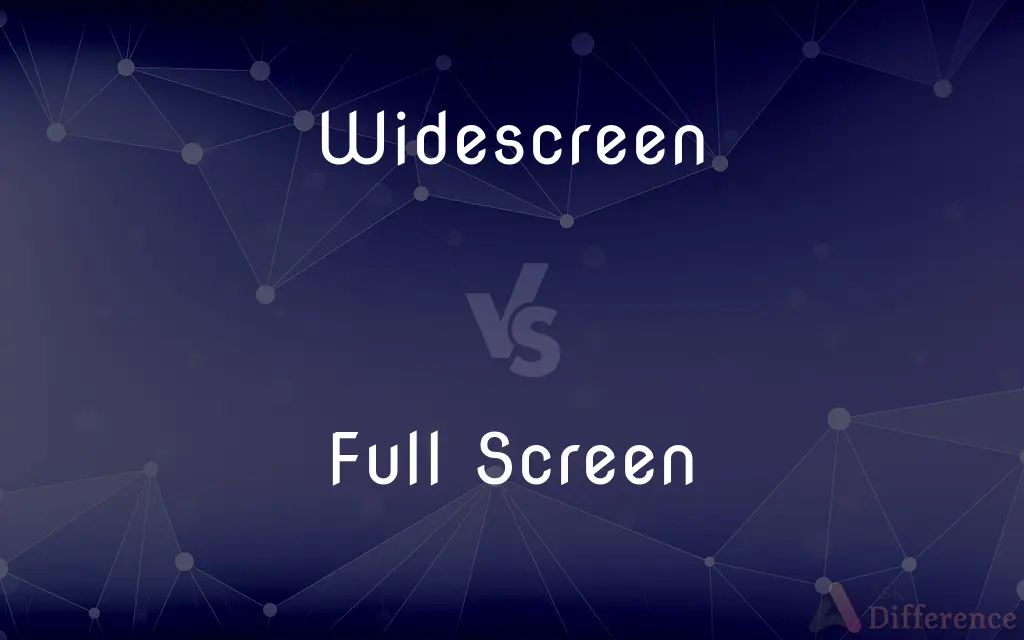Widescreen vs. Full Screen — What's the Difference?
By Maham Liaqat & Fiza Rafique — Published on February 28, 2024
Widescreen format (16:9) offers a broader view ideal for movies, while Full Screen (4:3) fits older TV shows and computer monitors, focusing on height over width.

Difference Between Widescreen and Full Screen
Table of Contents
ADVERTISEMENT
Key Differences
Widescreen, with its 16:9 aspect ratio, is designed to match the dimensions of modern digital TV screens and cinema formats, providing a wider field of view. This aspect ratio has become the standard for most contemporary visual media, enhancing the immersive experience by covering more of the viewer's field of vision.
Full Screen, or the 4:3 aspect ratio, was the standard for older televisions and computer monitors. It offers a more square-like viewing area that suits content produced before the widescreen era. This format is often associated with classic films and early television programming, where the emphasis was more on vertical details.
When converting between these two formats, widescreen content on a full-screen display may show black bars (letterboxing) to maintain the original aspect ratio without cropping. This preserves the director's intended framing but reduces the overall size of the image.
Displaying full-screen content on a widescreen monitor might involve either stretching the image to fill the screen, which distorts the original proportions, or placing vertical black bars (pillarboxing) on the sides to maintain the aspect ratio.
The preference for widescreen or full screen depends on the content being viewed and the viewer's desire for an immersive experience versus maintaining original aspect ratios. Widescreen is favored for most modern media and gaming for its expansive view, while full screen might be preferred for classic media and specific professional applications requiring a taller display area.
ADVERTISEMENT
Comparison Chart
Aspect Ratio
16:9
4:3
Preferred Usage
Modern movies, TV shows, and gaming
Classic movies, older TV shows
Field of View
Wider, more immersive experience
Taller, more focused on height
Compatibility
Modern digital TVs, monitors, and cinema screens
Older televisions and computer monitors
Conversion Impact
May result in letterboxing on full-screen displays
May result in pillarboxing or stretching on widescreen displays
Compare with Definitions
Widescreen
A format that enhances the cinematic experience with a wider field of view.
The widescreen version of the movie shows more of the scenic landscapes.
Full Screen
Suited for viewing older movies and TV shows.
Many collectors prefer the full screen versions of classic films for authenticity.
Widescreen
Suited for modern digital content and devices.
Her new widescreen monitor displays vibrant colors across its broad canvas.
Full Screen
Represents a bygone standard in visual media.
Full screen formats remind us of the early days of television and film.
Widescreen
Often requires letterboxing when displayed on non-native screens.
Watching a widescreen movie on an old TV often adds black bars on top and bottom.
Full Screen
A traditional format that emphasizes vertical content.
Classic TV shows are often better viewed in full screen.
Widescreen
Preferred for immersive gaming and cinematic content.
His widescreen setup immerses players more deeply into the game world.
Full Screen
Compatible with older media and technology.
Her vintage computer monitor only displays content in full screen.
Widescreen
Reflects the current standard in visual media.
Most online streaming content is now produced in widescreen format.
Full Screen
May involve pillarboxing or stretching on widescreen displays.
Playing a full screen video on a modern TV might distort the image.
Widescreen
A screen with a wider aspect ratio than the ordinary 35-millimeter frame, making more effective use of the human field of view and producing a more immersive view experience.
Widescreen
Of or relating to a display screen or an image with a width-to-height ratio greater than 4:3 and a typical ratio of 16:9.
Common Curiosities
Why do some people prefer full screen over widescreen?
Some prefer full screen for viewing classic content in its original aspect ratio or for specific applications that benefit from a taller display area.
Is widescreen better than full screen?
"Better" depends on the content and personal preference. Widescreen offers a more immersive view for modern media, while full screen suits classic content.
Can all TVs display both widescreen and full screen content?
Most modern TVs can display both formats, but the viewing experience may involve letterboxing or pillarboxing to preserve the original aspect ratio.
Is full screen obsolete?
Not obsolete, but less common. Full screen is still used for specific applications and to view content in its original format.
Do movies come in both widescreen and full screen formats?
Some DVDs and Blu-rays offer both formats, but widescreen is more common for contemporary releases.
How do widescreen and full screen affect gaming?
Widescreen provides a broader field of view in gaming, enhancing immersion, while full screen may limit peripheral vision but can be preferred for older games.
Can widescreen content be converted to full screen without loss?
Converting widescreen to full screen often involves cropping or letterboxing, which can result in loss of content or altered composition.
Are there any visual quality differences between widescreen and full screen?
Quality differences are more about aspect ratio and content presentation rather than inherent visual quality. However, stretching or cropping can impact perceived quality.
How does aspect ratio impact viewing experience?
Aspect ratio affects the composition and immersion of visual content, with widescreen providing a more cinematic feel and full screen focusing on vertical details.
Why was widescreen adopted as the standard?
Widescreen more closely matches human peripheral vision and has been adopted for its ability to provide a more immersive and cinematic experience.
How do filmmakers decide between widescreen and full screen formats?
Filmmakers typically choose based on the visual storytelling style, with widescreen being the preferred choice for its expansive and immersive qualities.
How does online streaming handle different aspect ratios?
Online streaming platforms typically offer content in widescreen to match modern display standards, with aspect ratio adjustments for other formats.
What should I consider when buying a new monitor or TV?
Consider the type of content you most often view or play, the available space, and whether you prefer a wider field of view (widescreen) or a traditional aspect ratio (full screen).
Can I change my device settings from widescreen to full screen?
Many devices allow you to adjust settings to display content in different aspect ratios, though this may not change the original content's format.
Is there a quality loss when stretching full screen content to fit a widescreen?
Stretching can distort the image, leading to a perceived decrease in quality due to altered aspect ratio.
Share Your Discovery

Previous Comparison
Financial Emergency vs. Financial Nonemergency
Next Comparison
Rock vs. Alternative RockAuthor Spotlight
Written by
Maham LiaqatCo-written by
Fiza RafiqueFiza Rafique is a skilled content writer at AskDifference.com, where she meticulously refines and enhances written pieces. Drawing from her vast editorial expertise, Fiza ensures clarity, accuracy, and precision in every article. Passionate about language, she continually seeks to elevate the quality of content for readers worldwide.
















































